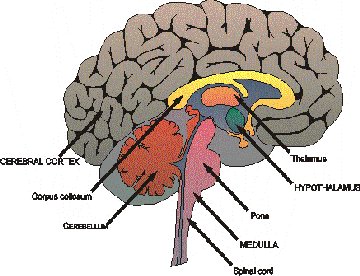Stopping tumours in their path
New study sheds light on most common and deadly form of brain cancer
Glioblastoma (GBM) is the most common and deadly form of primary malignant brain cancer accounting for approximately 15% of all brain tumours and occurring mostly in adults between the ages of 45 and 70. The aggressive recurrent nature of this cancer is only temporarily contained by combined surgery, chemotherapy and radiation treatment. The recurrence of GBM is usually fatal, resulting in an average patient survival time of less than two years. A new study from the Montreal Neurological Institute and Hospital - The Neuro - at McGill University, published in Nature Communications, identifies two specific key players in the growth of GBM.
A GBM tumour contains a complex combination of different cell types, including ‘stem-like’ cells that are able to initiate brain tumour growth, even when present in very small numbers. These cells, known as brain-tumour initiating cells (BTICs), are believed to be among the cells that can re-initiate GBM if they are not completely eradicated through surgery, radiation and chemotherapy. Thus, BTICs represent an important therapeutic target for GBM treatment strategies.
“We wanted to find out how GBM-derived BTICs are able to initiate a tumour with the ultimate goal of preventing the re-growth of this deadly form of brain cancer,” says Dr. Stefano Stifani, neuroscientist at The Neuro and senior investigator on the paper.
“What we found is that by impairing the activity of two transcription factors (proteins that control gene expression), termed FOXG1 and TLE, we can significantly reduce the ability of BTICs to give rise to brain tumours.” The researchers studied brain tumour growth in an in vivo mouse model using human GBM-derived BTICs. This approach provides what is called an in vivo environment that closely resembles the original human brain tumours. The demonstration that the FOXG1 and TLE proteins are important for the tumour-forming ability of human GBM-derived BTICs has long-term implications because FOXG1 and TLE control the expression of numerous genes. Identifying the genes whose expression is controlled by FOXG1 and TLE is expected to provide further information on the mechanisms involved in GBM tumourigenesis. In the long term, researchers hope to identify multiple important regulators, in order to find new potential therapeutic targets to impair the tumourigenic ability of BTICs.
 “The implication of transcription factors FOXG1 and TLE in the tumour-forming ability of BTICs opens the door to possible strategies to block tumour growth – a major advance in the fight against GBM.”
“The implication of transcription factors FOXG1 and TLE in the tumour-forming ability of BTICs opens the door to possible strategies to block tumour growth – a major advance in the fight against GBM.”
The Neuro’s Brain Tumour Program sees 3500 patients annually, and performs on average 450 tumour procedures per year. These procedures include surgeries for brain cancers such as GBM and other gliomas, as well as meningiomas, vestibular schwannomas, pituitary adenomas, metastases, among others.
Glioblastoma
 Glioblastomas (GBM) are tumors that arise from astrocytes - the star-shaped cells that make up the “glue-like,” or supportive tissue of the brain. These tumors are usually highly malignant (cancerous) because the cells reproduce quickly and they are supported by a large network of blood vessels.
Glioblastomas (GBM) are tumors that arise from astrocytes - the star-shaped cells that make up the “glue-like,” or supportive tissue of the brain. These tumors are usually highly malignant (cancerous) because the cells reproduce quickly and they are supported by a large network of blood vessels.
Location
Glioblastomas are generally found in the cerebral hemispheres of the brain, but can be found anywhere in the brain or spinal cord.
Description
Glioblastomas usually contain a mix of cell types. It is not unusual for these tumors to contain cystic mineral, calcium deposits, blood vessels, or a mixed grade of cells.
Glioblastomas are usually highly malignant - a large number of tumor cells are reproducing at any given time, and they are nourished by an ample blood supply. Dead cells may also be seen, especially toward the center of the tumor. Because these tumors come from from normal brain cells, it is easy for them to invade and live within normal brain tissue. However, glioblastoma rarely spreads elsewhere in the body.
There are two types of glioblastomas:
Primary, or de novo: These tumors tend to form and make their presence known quickly. This is the most common form of glioblastoma; it is very aggressive.
Secondary: These tumors have a longer, somewhat slower growth history, but still are very aggressive. They may begin as lower-grade tumors which eventually become higher grade. They tend to be found in people 45 and younger, and represent about 10% of glioblastomas.
 This research, which was supported by the Canadian Institutes of Health Research and the Cancer Research Society, highlights the benefits of The Neuro’s integrated model – where clinicians collaborate closely with researchers, to significantly advance neuroscience and clinical care for patients with neurological disease.
This research, which was supported by the Canadian Institutes of Health Research and the Cancer Research Society, highlights the benefits of The Neuro’s integrated model – where clinicians collaborate closely with researchers, to significantly advance neuroscience and clinical care for patients with neurological disease.
The Neuro
The Montreal Neurological Institute and Hospital - The Neuro, is a unique academic medical centre dedicated to neuroscience. Founded in 1934 by the renowned Dr. Wilder Penfield, The Neuro is recognized internationally for integrating research, compassionate patient care and advanced training, all key to advances in science and medicine. The Neuro is a research and teaching institute of McGill University and forms the basis for the Neuroscience Mission of the McGill University Health Centre. Neuro researchers are world leaders in cellular and molecular neuroscience, brain imaging, cognitive neuroscience and the study and treatment of epilepsy, multiple sclerosis and neuromuscular disorders. For more information, visit theneuro.com.
###
Contact Information
Contact: Anita Kar
Organization: The Neuro
Email: .(JavaScript must be enabled to view this email address)